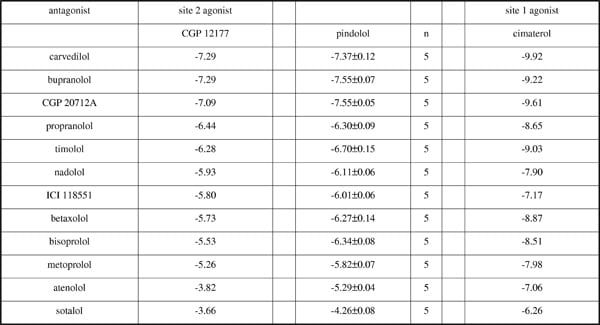The β1-adrenoceptor is now considered to exist in two different states or conformations. Catecholamines bind to and activate responses via the classical site (site 1) of the receptor that are sensitive to antagonism by classical β-blockers. Agonists responses elicited via the secondary site (e.g. the agonist response to CGP 12177) are relatively resistant to inhibition by classical β-antagonists. In CHO cells stably expressing the human β1-adrenoceptor at 1100fmol/mg protein, pindolol has previously been demonstrated to stimulate both sites of the receptor (Baker et al., 2003). The aim of this study was to examine this pindolol response further using CHO cells stably expressing a lower level of the human β1-adrenoceptor (79 fmol/mg protein) and a CRE-luciferase reporter gene. Luciferase gene transcription measurements were carried out as previously reported (Baker et al., 2003). Pindolol stimulated a mono-phasic classical sigmoidal agonist concentration response curve in these lower expressing cells (log EC50 -5.74 ± 0.03, n=8; 16.4 ± 0.4% isoprenaline maximum). In the presence of fixed concentrations of the site 1 agonist cimaterol, low concentrations of pindolol inhibited the cimaterol response where as higher concentrations of pindolol were required to stimulate the agonist response. This is very similar to that seen with CGP 12177 (see Konkar et al., 2000; Baker, 2005) confirming that pindolol binds to site 1 with high affinity but suggest that the agonist response was occurring via a different site. The ability of a range on antagonists to inhibit the pindolol response was then examined (see Table). For some ligands (e.g. nadolol and ICI 118551) the Log KD values obtained were similar to those obtained when CGP 12177 was an agonist, however others (e.g. atenolol) were markedly different. This suggests that the agonist response of pindolol might not be acting through the same secondary site as CGP 12177.
Life Sciences 2007 (2007) Proc Life Sciences, PC462
Poster Communications: The pharmacology of agonist responses to pindolol at the β1-adrenoceptor
J. G. Baker1
1. Institute of Cell Signalling, University of Nottingham, Nottingham, United Kingdom.
View other abstracts by:
Table 1
Where applicable, experiments conform with Society ethical requirements.

